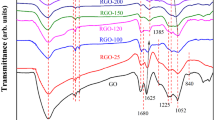Abstract
In this article, we report a study carried out to understand how changes in environment and temperature, in which the graphene oxide (GO) film reduction occurs, alter the electrical properties of the resulting films. In fact, it is possible to improve the GO reduction efficiency by choosing suitable environment and temperature. To this purpose, three different environments (high vacuum, air and nitrogen) and three dissimilar temperatures (177 °C, 300 °C and 600 °C) have been chosen, as suggested by differential scanning calorimetry (DSC) measurements. Among the investigated thermally reduced graphene oxide films, the ones treated at 600 °C in nitrogen have shown to possess higher electrical conductivity. Such an enhanced electrical conductivity can be attributed to reduction of oxygen functional groups and restoration of sp2 carbon network, as confirmed by Raman spectra.









Similar content being viewed by others
References
L. Silipigni, M. Fazio, B. Fazio, M. Cutroneo, L. Torrisi, Tailoring the oxygen content of graphene oxide by IR laser irradiation. Appl. Phys. A 124(545), 1–12 (2018)
L. Silipigni, M. Cutroneo, G. Salvato, L. Torrisi, In-situ soft X-ray effects on graphene oxide films. Radiat. Eff. Defects Solids 173(9–10), 740–750 (2018)
D. Chen, H. Feng, J. Li, Graphene oxide: preparation, functionalization, and electrochemical applications. Chem. Rev. 112, 6027–6053 (2012)
D. Zhan, Z. Ni, W. Chen, L. Sun, Z. Luo, L. Lai, T. Yu, A.T.S. Wee, Z. Shen, Electronic structure of graphite oxide and thermally reduced graphite oxide. Carbon 49, 1362–1366 (2011)
L. Silipigni, G. Salvato, G. Di Marco, B. Fazio, A. Torrisi, M. Cutroneo, L. Torrisi, Band-like transport in high vacuum thermal reduced graphene oxide films. Vacuum 165, 254–261 (2019)
L. Torrisi, L. Silipigni, M. Cutroneo, Radiation effects of IR laser on graphene oxide irradiated in vacuum and in air. Vacuum 153, 122–131 (2018)
M. Cutroneo, V. Havrane, A. Mackova, P. Malinski, L. Torrisi, J. Lorincik, J. Luxa, K. Szokolova, Localized deoxygenation of graphene oxide foil by ion microbeam writing. Vacuum 163, 10–14 (2019)
M. Cutroneo, V. Havranek, A. Mackova, P. Malinsky, L. Torrisi, L. Silipigni, B. Fazio, A. Torrisi, K. Szokolova, Z. Sofer, J. Stammers, Effects of the ion bombardment on the structure and composition of GO and rGO foils. Mater. Chem. Phys. 232, 272–277 (2019)
P. Zhang, Z. Li, S. Zhang, G. Shao, Recent advances in effective reduction of graphene oxide for highly improved performance toward electrochemical energy storage. Energy Environ. Mater. 1, 5–12 (2018)
D. Du, P. Li, J. Ouyang, Nitrogen-doped reduced graphene oxide prepared by simultaneous thermal reduction and nitrogen doping of graphene oxide in air and its application as an electrocatalyst. ACS Appl. Mater. Interfaces 7, 26952–26958 (2015)
T.E. Timofeeva, Z.I. Evseev, P.V. Vinokurov, G.N. Alexandrov, S.A. Smagulova, The effect of temperature conditions during graphene oxide synthesis on humidity dependence of conductivity in thermally reduced graphene oxide. J. Struct. Chem. 59(4), 799–805 (2018)
I. Sengupta, S. Chakraborty, M. Talukdar, S.K. Pal, S. Chakraborty, Thermal reduction of graphene oxide: how temperature influences purity. J. Mater. Res. 33(23), 4113–4122 (2018)
Graphenea, High quality graphene producer, actual website 2020. https://www.graphenea.com/. Accessed 3 June 2020
L.C. Feldman, J.W. Mayer (eds.), Fundamentals of Surface and Thin Film Analysis (Elsevier, New York, 1986)
Y. Qiu, F. Collin, R.H. Hurt, I. Külaots, Thermochemistry and kinetics of graphite oxide exothermic decomposition for safety in large-scale storage and processing. Carbon 96, 20–28 (2016)
K. Yin, H. Li, Y. Xia, H. Bi, J. Sun, Z. Liu, L. Sun, Thermodynamic and kinetic analysis of low-temperature thermal reduction of graphene oxide. Nano-Micro Lett. 3(1), 51–55 (2011)
O.M. Slobodian, P.M. Lytvyn, A.S. Nikolenko, V.M. Naseka, O.Y. Khyzhun, A.V. Vasin, S.V. Sevostianov, A.N. Nazarov, Low-temperature reduction of graphene oxide: electrical conductance and scanning kelvin probe force microscopy. Nanoscale Res. Lett. 13, 139 (2018)
S.N. Alam, N. Sharma, L. Kumar, Synthesis of graphene oxide (GO) by modified hummers method and its thermal reduction to obtain reduced graphene oxide (rGO). Graphene 6, 1–18 (2017)
N.F. Mott, E.A. Davis, in Electronic Processes in Non-crystalline Materials, 2nd edn. (Clarendon Press-Oxford, 1979) Chap.2
A. Bhaumik, J. Narayan, Conversion of p to n-type reduced graphene oxide by laser annealing at room temperature and pressure. J. Appl. Phys. 121, 125303 (2017)
X. Diez-Betriu, S. Alvarez-Garcia, C. Botas, P. Alavrez, J. Sanchez-Marcos, C. Prieto, R. Menendez, A. de Andres, Raman spectroscopy for the study of reduction mechanisms and optimization of conductivity in graphene oxide thin films. J. Mater. Chem. C. 1, 6905–6912 (2013)
C.-Y. Su, Y. Xu, W. Zhang, J. Zhao, X. Tang, C.-H. Tsai, L.-J. Li, Electrical and spectroscopic characterizations of ultra-large reduced graphene oxide monolayers. Chem. Mater. 21, 5674–5680 (2009)
V.B. Mohan, K. Jayaramana, M. Stammb, D. Bhattacharyya, Physical and chemical mechanisms affecting electrical conductivity in reduced graphene oxide films. Thin Solid Films 616, 172–182 (2016)
A. Danciu, I. Mihalache, M. Danila, B. Bita, R. Plugaru, The effect of annealing in nitrogen atmosphere on the structure, photoluminescence and electrical properties of Li and Cu doped sol–gel ZnO films, International Semiconductor Conference (CAS), (IEEE, Sinaia, 2014), pp. 77–80
Acknowledgements
The authors thank the INFN-Sezione di Catania, CIMA Project for the support given to develop the presented research.
Author information
Authors and Affiliations
Corresponding author
Additional information
Publisher's Note
Springer Nature remains neutral with regard to jurisdictional claims in published maps and institutional affiliations.
Rights and permissions
About this article
Cite this article
Silipigni, L., Salvato, G., Fazio, B. et al. Temperature and environment effects on the graphene oxide reduction via electrical conductivity studies. J Mater Sci: Mater Electron 31, 11847–11854 (2020). https://doi.org/10.1007/s10854-020-03738-4
Received:
Accepted:
Published:
Issue Date:
DOI: https://doi.org/10.1007/s10854-020-03738-4



